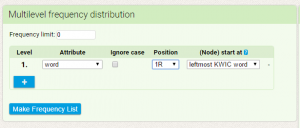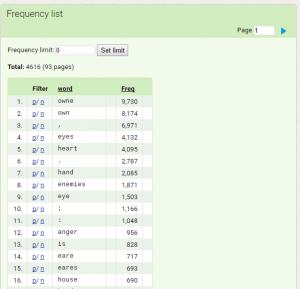Lesson 6: Morphology I
In Early Modern English, there was a number of morphemes which carried essentially the same meaning. For example, the plural markers < -en> and < -s> were sometimes interchangeable, as in shoon or shoos (shoes). One such pair of allomorphs are the second person possessive adjectives thy and thine, which occurred in complementary distribution.
Second person possessive adjectives
Before the regularization resulting in today’s form your, Early Modern English had two forms, thy and thine, both of which functioned as second person possessive adjectives, as in thy beautiful face and thine eyes. We might immediately think that the distinction is analogous to present day my and mine. However, it was not as straightforward. In Early Modern English the two pairs of possessives behaved as they do today, i.e. the possessive adjective my (and EModE thy) occurs before a noun and has the role of determiner, whereas mine (and EModE thine) is a proper possessive pronoun which generally stands at the end of a clause or sentence. However, what is today a possessive pronoun proper was previously known to function also as a possessive adjective, as in I saw it with mine own eyes and Thine eyes are fair.
It appears to be the case that the thy/ thine allomorphs are distributed similarly to the a/ an pair, i.e. the difference lies in the pronunciation of the two allomorphs. That is to say that in Early Modern English, the use of the two forms was dependent on the phonetic environment, specifically the following speech sound. Therefore thy could be expected to appear before words beginning with a consonant, whereas thine occurred before vowels.
Searching the corpus
If we want the results to include both forms, the query in EEBO can be expressed with the help of the vertical bar thus:
[word=„thy“]|[word=„thine“]
Naturally, there are many other spelling variants; for example thaw from Northern dialects, theye from Northumberland, thoi from Lancaster. Unfortunately, there is no way in which we could tell them apart from their homonyms (words written and pronounced in the same way, but with a different meaning). Let us therefore restrict our search to the canonical variants.
Question: The concordance view shows a random grouping of all the results, including both thy and thine. How can we select one form from these results and view it separately?
By going to Frequency → Node forms, we can see all of the forms returned by our search, which is in this case just the two. Underneath Filter, we can click on “p” or “n” depending on whether we want a positive filter (we see only the results with the given form) or a negative filter (we see all the results but those with the selected form). This is useful with a larger number of node forms.
When we select a positive filter for the variant thine we get a list of results containing this form. Frequency → Custom → Multilevel Frequency Distribution allows us to explore the words which most frequently follow thine. In order to see a list of words which occur immediately following it (1st position to the right of the node), we select the position 1R.
The list shows that thine is most often followed by a vowel, or a word beginning with <h>. This is most probably due to the fact that the initial <h> was often dropped, and this was not always reflected by the spelling. It is very plausible that what was in fact pronounced in these examples (heart, hand) was in fact a vowel. The form thine also frequently appears at the end of a clause or sentence, which is denoted by the presence of a comma or full stop (less often a semicolon). In these cases we speak of the possessive pronoun The heav’ns are thine, not the possessive adjective I will deliver thine enemy into thine hand. Once again we may use the positive/ negative filters to view the concordance view for the individual results, e.g. all cases of the phrase thine eares.
The frequency list of words in the 1R position to the node thine:
Task 1: Compare thy and thine
- Compare the results for thine with those for thy.
- Are the two forms in complementary distribution or are there overlapping contexts?
- What do the result tell us about words such as heart and hand?
Task 2: Try another pair of allomorphs
- Search for orrible and horrible.
- Think about possible spelling variants; can they be included in the search?
- See how the phonetic environment affects the dropping of the [h].
- Does the corpus testify the existence of too orrible? Why/ why not?
- Make sure that the Query type is set to CQL.
If you are ready, you can continue to Lesson 7.


